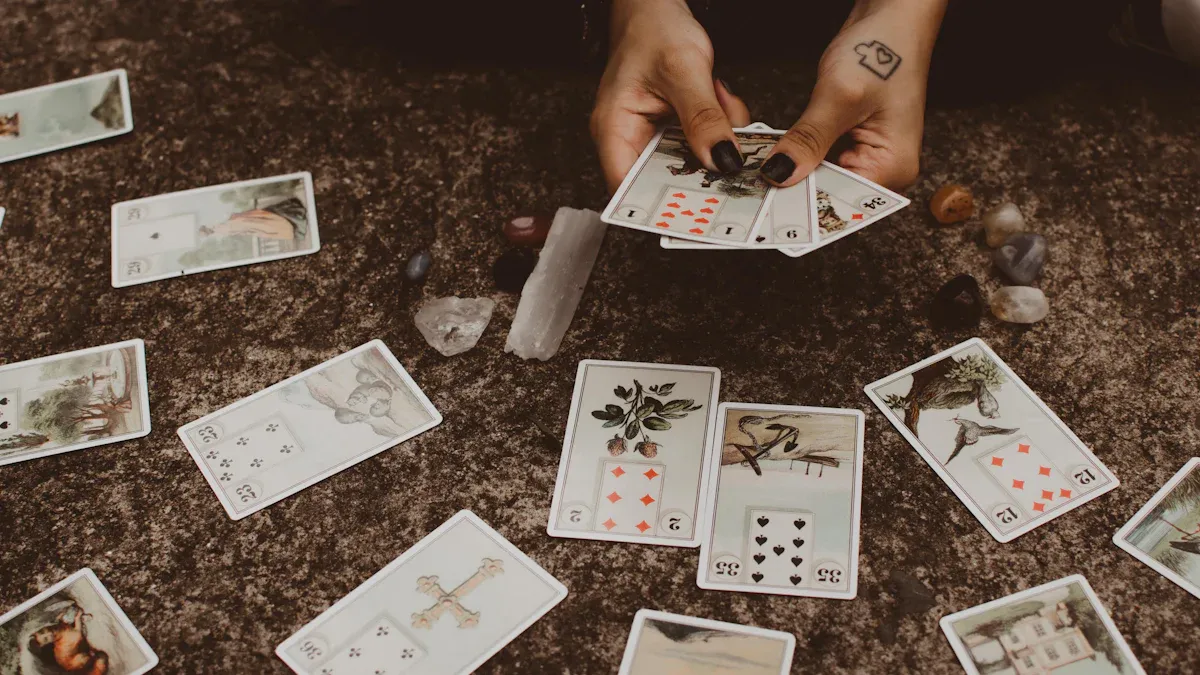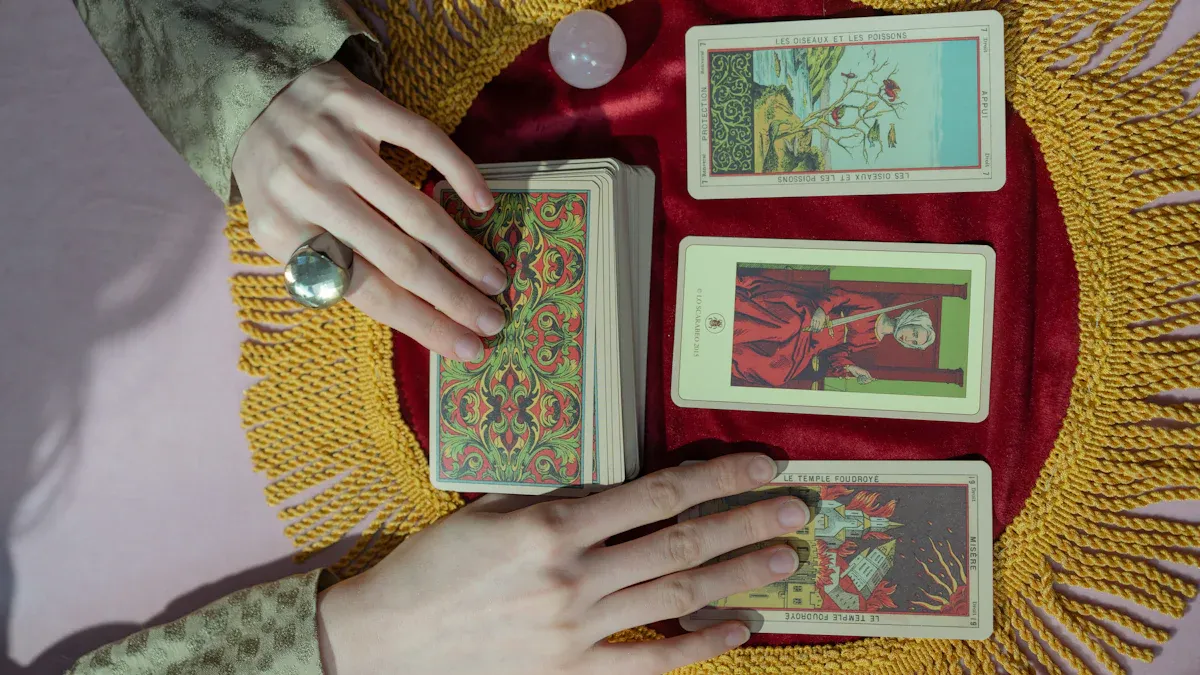
Yes or no tarot readings provide a simple and direct way to receive answers to your specific questions. They’re ideal when you need clarity. However, here’s the important part: how you phrase your question is crucial. If ate yes no questions are not framed with precision, the reading may come across as unclear. To achieve the best outcomes, channel your energy, set a clear intention, and trust your intuition. Tarot works most effectively when you’re ready and open to its guidance.
Key Takeaways
Decide what you want before starting your tarot reading. This helps you focus and connect with the cards’ advice.
Write clear yes or no questions. Simple questions give better answers and make your reading more helpful.
Find a quiet place for your reading. A peaceful space helps you understand the cards and trust your feelings.
Preparing for Yes or No Tarot Readings

Preparation is key when it comes to yes or no tarot readings. Taking the time to set your intentions, craft the precise yes or no question, and create a calm environment can make all the difference in the clarity of your answers. Let’s explore these steps in detail.
Setting Intentions for the Reading
Before you begin, think about why you’re doing this reading. What’s your goal? Setting clear intentions helps you focus your energy and align with the wisdom of the tarot. The High Priest card, for example, reminds us to trust our inner wisdom and take action toward what we truly desire. When your intentions are clear, the cards are more likely to provide meaningful guidance.
Here’s a tip: Spend a few moments reflecting on your motivation. Are you seeking clarity, reassurance, or direction? Align your thoughts with your desired outcome, and trust the process.
Crafting the Precise Yes or No Question
Knowing how to ask the question is crucial. The precise yes or no question will lead to clearer answers. Vague questions, like “Will I be happy?” often result in unclear responses. Instead, focus on specific scenarios. For example:
Should I take this job?
Should I call them today?
Should I enroll in this class?
These types of yes or no questions help the tarot cards provide direct and actionable insights. Remember, the more precise your question, the more precise your answer.
Creating a Focused and Calm Environment
Your surroundings matter. A quiet, distraction-free space allows you to connect with the cards and your intuition. Before starting, try raising your vibration by doing something you enjoy, like listening to music or meditating. This helps you approach the reading with an open mind and positive energy.
You can also prepare by organizing your thoughts. Write down a list of questions in order of importance. This ensures you address your most pressing concerns first. When you’re ready, take a deep breath, shuffle the cards, and let your intuition guide you.
Pro Tip: Approach the reading without fear or rigid expectations. Openness allows the tarot to reveal its wisdom more clearly.
Performing the Reading Step-by-Step

Now that you’ve prepared yourself and your space, it’s time to dive into the actual tarot card reading. Follow these steps to ensure you get the most accurate and meaningful results.
Shuffling and Drawing Cards
Start by shuffling your tarot deck. This step isn’t just about mixing the cards; it’s about infusing them with your energy and intention. As you shuffle, focus on your question. Keep it clear and specific. For example, if you’re asking, “Should I take this job?” visualize the situation and let your energy flow into the cards.
Once you feel ready, stop shuffling and draw a card. You can either pick one from the top of the deck or spread the cards out and choose one intuitively. Trust your gut here—it’s part of the process. If you’re using yes/no spreads, you might draw multiple cards, but for a simple answer, one card often does the trick.
Tip: Don’t rush this step. Take your time to connect with the cards. The more focused you are, the clearer your answer will be.
Using Upright and Reversed Cards for Answers
In tarot reading, the orientation of the card—upright or reversed—plays a big role in determining the answer. Upright cards often lean toward a “yes,” while reversed cards suggest a “no” or “not yet.” For instance, The World reversed indicates unfinished business. In love-related questions, it points to unresolved challenges, often leaning toward a “no.” For career inquiries, it suggests stagnation or delays, which usually means “not right now.”
Here’s a quick guide to interpreting upright and reversed cards:
Upright cards: Generally positive and affirming. They often provide a clear yes or no answer aligned with your question.
Reversed cards: Highlight obstacles or delays. They might suggest that the timing isn’t right or that more work is needed before moving forward.
Remember, the meaning of each card can vary depending on the context of your question. Always consider the card’s symbolism and how it relates to your situation.
Applying Intuition to Interpret Results
Your intuition is your best friend during a tarot card reading. While the cards provide guidance, your inner voice helps you interpret their message. After drawing a card, take a moment to reflect on the reading. What feelings or thoughts come up? Does the card’s imagery resonate with your question?
For example, if you draw The Lovers card upright while asking about a relationship, it might indicate harmony and a “yes” answer. But if it’s reversed, it could suggest misalignment or a need for deeper communication, leaning toward a “no.” Trust what your instincts tell you.
Pro Tip: If the answer feels unclear, try journaling about the card and your question. Writing can help you uncover insights you might not notice right away.
By combining the card’s meaning with your intuition, you’ll gain a deeper understanding of the message. Tarot isn’t just about simple answers; it’s about exploring the layers of meaning behind each card.
Interpreting Yes or No Questions with Tarot
Determining Yes, No, or Maybe Answers
When it comes to yes or no tarot readings, the goal is to get a clear answer. But sometimes, the cards might not give you a straightforward “yes” or “no.” Instead, they might suggest a “maybe” or a conditional response. Here’s how you can interpret the cards effectively:
Categorize the cards: Some readers like to sort their deck into three piles—Yes, No, and Maybe—based on the traditional meanings of the cards. For example, The Sun often represents a “yes,” while The Tower might lean toward a “no.”
Consider upright and reversed positions: Upright cards generally point to a “yes,” while reversed cards often suggest a “no” or a delay. For instance, The Chariot upright could mean forward movement (a “yes”), but reversed, it might indicate obstacles (a “no”).
Look for conditional answers: Sometimes, a card might say, “Yes, if…” or “No, if…” based on its symbolism. For example, The Star might suggest a “yes” if you stay hopeful and patient.
Your mindset plays a big role here. If you approach the reading with clarity and focus, you’ll find it easier to interpret the cards and their messages.
Balancing Card Context with Intuition
Tarot card reading isn’t just about memorizing meanings. It’s also about trusting your intuition. The context of your question and the imagery on the card can guide you toward the right answer. Here’s how you can balance both:
Pay attention to the card’s story: Each card tells a story. For example, if you draw The Fool, think about its meaning in your situation. Does it suggest taking a leap of faith? Or does it warn against being reckless?
Trust your gut: Your intuition is a powerful tool. If a card feels like it’s saying “yes,” even if the traditional meaning suggests otherwise, trust your instincts. The cards are a guide, but your inner voice knows your situation best.
Consider the bigger picture: Sometimes, a single card might not give you the full answer. Think about how it fits into your life and the question you’re asking.
Balancing context with intuition helps you get answers that feel personal and meaningful. It’s not just about what the cards say—it’s about how they resonate with you.
Using Majority Rule for Multiple Cards
If you’re using more than one card in your reading, the majority rule method can help you interpret the answer. This approach works well when you want a more detailed perspective. Here’s how it works:
Draw three cards: This is a common spread for yes or no questions. Each card represents a vote—Yes, No, or Maybe.
Count the votes: If two or more cards lean toward “yes,” that’s your answer. If two or more lean toward “no,” then the answer is likely no. If there’s a mix, it might suggest uncertainty or a “maybe.”
Consider the overall energy: Even if the majority points to one answer, the individual cards still matter. For example, if you get two “yes” cards and one “no,” look at the “no” card to see if it highlights any challenges or conditions.
This method gives you a balanced view and helps you see the nuances in your situation. It’s especially helpful when you’re unsure about when to use this type of reading for complex questions.
Tip: Keep practicing! The more you work with your cards, the easier it becomes to interpret their messages.
Yes or no tarot readings work better with proper steps. Start by preparing with clear intentions. Perform the reading with care and focus. Use your intuition to understand the results. Practicing often helps you improve and feel more confident. For instance:
Psychic practice boosts focus and understanding, key for good readings.
It stops you from adding personal ideas to tarot meanings.
Following an 8-step prep plan helps you get clear answers.
Always remember, tarot gives guidance, not definite answers. Trust yourself, stay open-minded, and enjoy learning through the process.
FAQ
How many cards should I draw for a yes or no tarot reading?
You can draw one card for simplicity or three cards for deeper insights. Trust your intuition to decide what feels right.
Can I use any tarot deck for yes or no readings?
Yes, any tarot deck works. Choose one that resonates with you. Familiarity with the deck enhances your tarot card reading experience.
What if the answer feels unclear?
If the answer seems vague, reflect on the card’s imagery or journal your thoughts. Sometimes, the message unfolds with time and practice.


